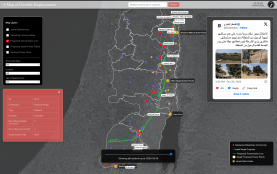| Date Ongoing | Publication 01 April 2025 | Location West Bank, Occupied Palestinian Territory |
| Forum Advocacy, Legal Process | Commissioned By Self-initiated | Methodologies OSINT, Data Mining, Geolocation, Ground Truth, Mapping, Remote Sensing, Fieldwork, Pattern Identification |
| Area Israel's Settlement Enterprise, Land Confiscation, Settler Violence | ||
| Launch Platform | ||
Executive Summary:
Since 7 October 2023, Al-Haq’s Forensic Architecture Investigation Unit (FAI) has documented the systematic forcible displacement of over 46 Bedouin communities in the occupied West Bank by Israeli occupying authorities and settlers illegally residing in occupied Palestinian territory (oPt). These were not random acts; they constitute a calculated element of Israel’s decades-long settler-colonial strategy aimed at reshaping the West Bank into an energy reserve to serve Israeli interests as part of its wider project to eliminate the indigenous Palestinian people and replace them with Jewish Israelis.
Our investigation reveals that most of the communities displaced since October 2023 were in the vicinity of a significant infrastructure development: a proposed 400 KiloVolt Israeli electricity transmission line strategically aligned with power plants and solar fields located in the occupied West Bank. This transmission line is central to Israel’s energy plan for 2030, positioned to deepen Palestinian dependence on the Israeli power grid. Located near existing and proposed Israeli solar installations, this infrastructure prioritises the supply of energy to illegal settlements and integrating occupied Palestinian territory into Israel’s national energy strategy, thus amounting to the further pillaging of Palestinian natural resources.
Israel frequently employs control over electricity and water infrastructure as tools of control and domination, while intentionally denying Palestinian communities in Area C access to essential services like power and water networks. By withholding these necessities, Israel creates a coercive environment that pressures these communities to leave, often contributing to their forcible displacement.
Through our documentation, we identified the following pattern: Israeli settlers establish illegal outposts in the oPt, terrorise Palestinian communities and forcibly displace the residents, while the Israeli government subsequently establishes and expands Israeli infrastructure in those areas. The aforementioned electricity transmission networks is a textbook example of such a pattern. This coordinated pattern disrupts the territorial contiguity of the oPt and obstructs the return of displaced Palestinians.
In sum, the displacement of Palestinian communities is not isolated or coincidental but forms part of a broader strategic blueprint aimed at colonising Palestinian territory, appropriating land and resources, and embedding Palestinian communities in perpetual dependency and displacement, thus solidifying Israel's long-term settler-colonial objectives.
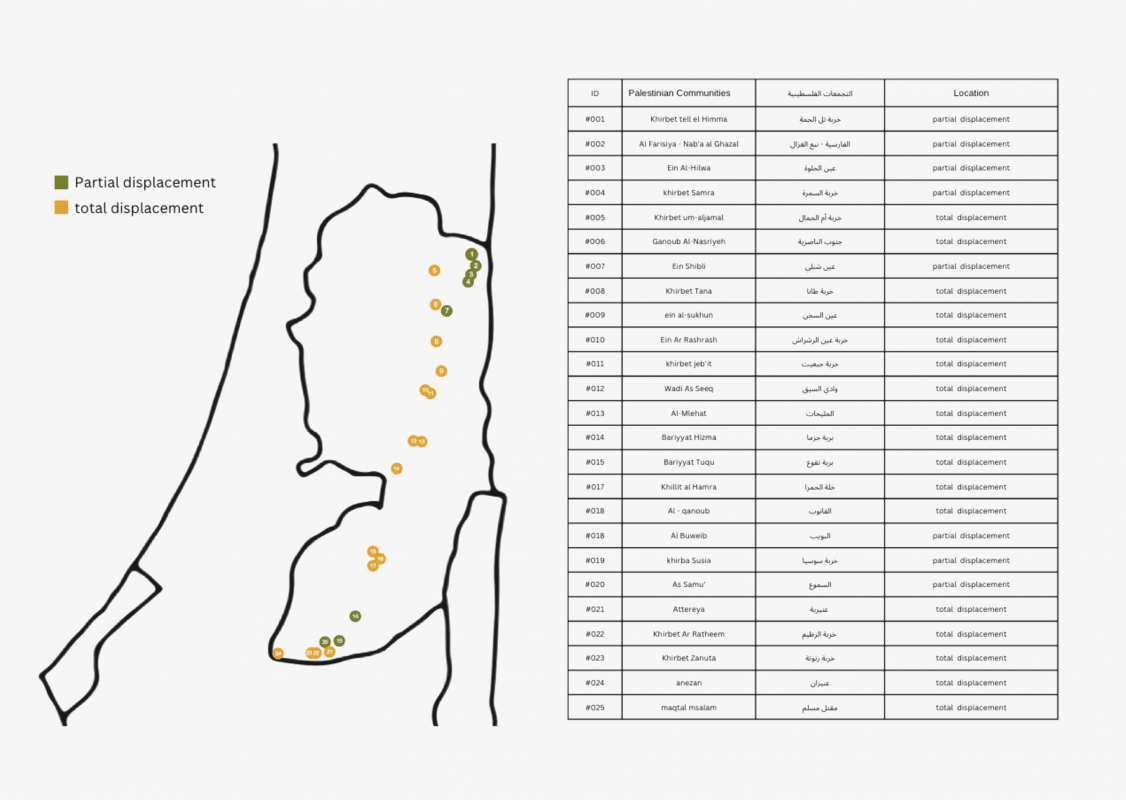
A map illustrating the location of partial and total displacements in the Occupied West Bank in October and November (2023).
Source: Al-Haq 2025
Methodology:
The investigation utilised advanced mapping techniques to identify the locations of displaced communities and compare them with Israeli settlements and newly constructed infrastructure on confiscated land, revealing clear spatial patterns of displacement and settlement expansion. Israeli planning documents were also analysed, including data extracted from the planning system, to establish the direct connection between displacement operations and future settlement infrastructure projects.
We relied on documented field testimonies from displaced residents, cross-referencing their accounts with visual documentation that captured settler attacks and demolitions carried out by the Israeli occupying authorities. In addition, precise statistical data was gathered on the number of affected families, categorising communities by the extent of their displacement, whether partial or total.
The investigation also tracked the illegal expansion of new settler outposts established over the past year, directly linking these developments to the escalation of settler violence. Finally, we analysed Israeli policies and official documents, revealing how infrastructure projects—such as electricity networks and renewable energy developments—are being used to reinforce the settlement enterprise.
Introduction:
Since 7 October 2023, there has been a marked surge in settler violence, directly linked to the mass forcible displacement of Palestinian Bedouin communities. However, this surge is part of broader, long-standing discriminatory planning and zoning policies by Israeli occupying authorities, and a coercive environment designed to force these communities to leave. A coercive environment refers to actions that pressure individuals or groups to force them to flee their homes, such as through violence, intimidation, or the denial of basic needs. These tactics amount to the crime of forcible displacement, as they effectively compel people to leave, violating the prohibition against such actions under international law, including the Fourth Geneva Convention, as well as the Rome Statute, which defines forcible displacement as including not just physical force but also threats or coercion, such as those caused by fear of violence, duress, detention, psychological oppression, or abuse of power. Our investigation revealed a geographic link between the displacement of these communities and the proposed illegal Israeli infrastructure developments in the occupied West Bank.
A Pattern of Settler Violence and Erasure:
Through our investigation, we have observed a disturbing and recurring pattern of forcible displacement in the communities we have documented. The sequence typically begins with the establishment of an illegal Israeli outpost — in 2023 and 2024 combined, 91 new outposts were established. While some outposts are retroactively legalized by the Israeli government, others are then provided with infrastructure and support by the Israeli occupying authorities. Settlers in these outposts frequently carry out violent actions against Palestinian communities, using intimidation and threats to force residents to flee. For example, the Wadi Al-Seeq community was threatened by armed settlers with death if they did not leave within the hour.
In certain instances, the Israeli Occupying Forces (IOF) not only actively escort and protect violent settlers but also engage in attacks against Palestinians themselves, thereby enabling the displacement of Palestinians through the threat and exercise of extreme violence. In 2024 alone, over 1,400 settler attacks were recorded. Notably, of these, 255 occurred within just six weeks following 7 October 2023. Many of these attacks were carried out by settlers in Israeli army uniforms, working in tandem with the IOF. The violence escalated further when Israel’s Minister of National Security, Itamar Ben-Gvir, armed thousands of settlers, primarily with U.S.-made M16 assault rifles. With impunity granted by all levels of the Israeli state, settler violence is unquestionably a state-backed policy, deliberately used as a tool to forcibly displace Palestinian communities from strategically important areas, further entrenching the process of erasure.
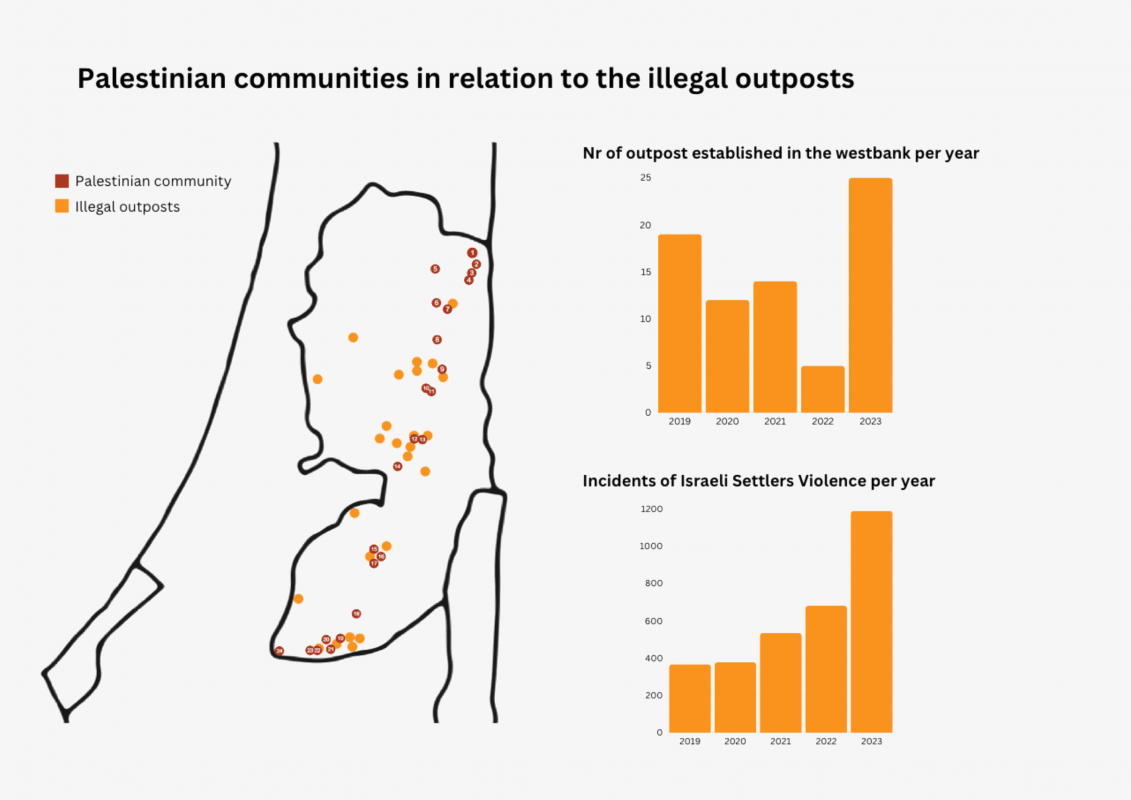
A map illustrating the location of Palestinian communities in relation to illegal outposts in the Occupied West Bank in October and November (2023).
Source: Al-Haq 2025
The Weaponization of Infrastructure: Israel’s use of Discriminatory Planning and Zoning Policies
Beyond direct violence, a slower form of displacement unfolds through discriminative planning and zoning policies employed by Israel.
The image below highlights the existing power lines in the occupied West Bank. Palestinians are compelled to rely on the Israeli electricity grid, as in much of the West Bank, while infrastructure permits, licenses, and allocations for infrastructure must be obtained from the Israeli occupying authorities, which are near-impossible to obtain. This situation forces Palestinian dependency on Israeli power lines in the West Bank, with electricity that Israel then sells to them at inflated prices. It is notable that such infrastructure is not present around areas where there are no Israeli settlements, such as Jenin, and the power lines are particularly concentrated around settlement clusters, such as those in the Nablus area. This reflects a strategic effort to support and expand illegal settlement activity, rather than providing services to Palestinians.
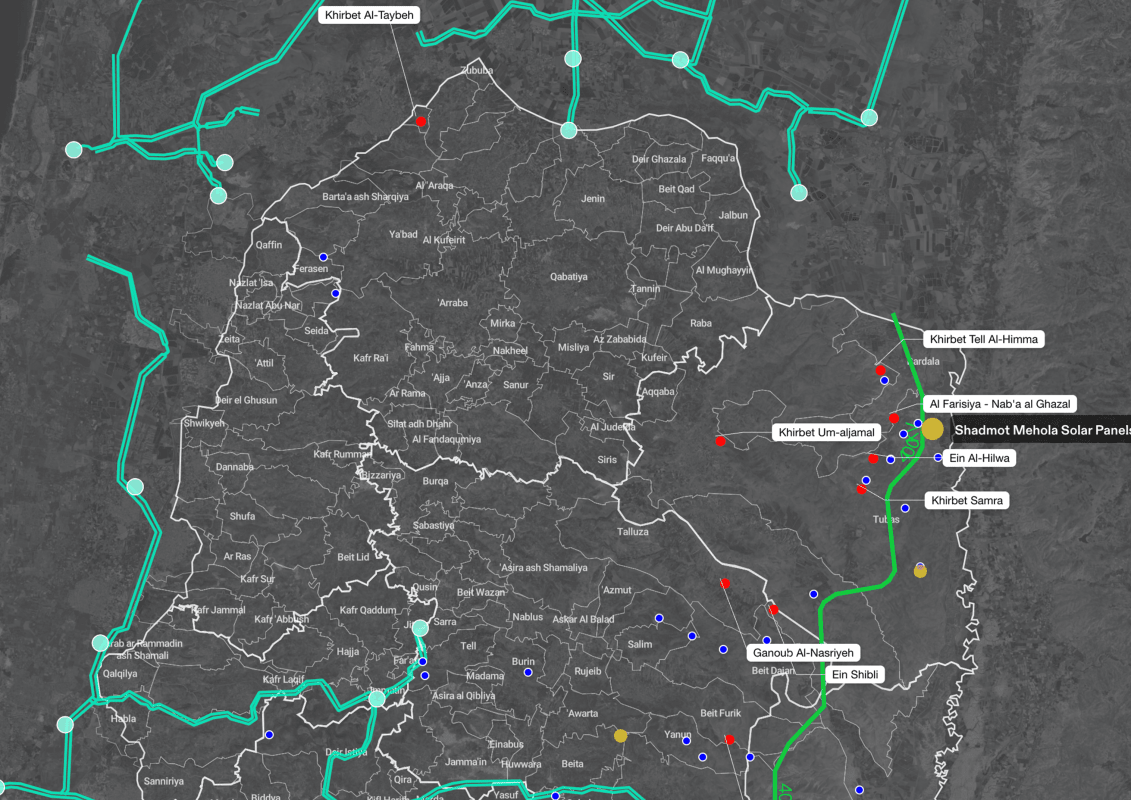
A map illustrating the absence of high voltage Israeli power transmission lines in Palestinian areas with no major Israeli Settlements such as Jenin in the Occupied West Bank.
Source: Al-Haq 2025
In March 2023, Israel seized 2,640 dunams (652 acres) of Palestinian land in the east Jerusalem periphery, and reclassified as “state land”. Subsequently, the Abu Nawar and Abu Al-Sultan Bedouin communities were erased and the residents displaced, as well as part of the Wadi Abu Hindi community. Our mapping reveals a strategic motive of their displacement: these communities stood between Israeli settlements Ma’ale Adumim, Kedar, and South Kedar. Their elimination enables the establishment of a territorial contiguity between settlements on the expense of the fragmentation of occupied Palestinian land.
Over a 17-month period, we monitored how the Israeli occupying authorities allowed for the rapid expansion of settlement infrastructure — new roads, power lines, and water pipelines servicing illegal settlements and outposts — while Palestinian communities were deliberately deprived, denied water access, electricity, and roads. This goes far beyond mere deprivation: When Palestinians attempt to adapt to this coercive environment by creating solutions, such as using water tanks and solar panels, Israeli authorities invoke military orders such as Order 1252, which allows for the confiscation of ‘movable structures’ under the pretext of lacking the required permits.
An incident that starkly exemplifies the brutality of these policies within Israel's settler-colonial apartheid system is when an Israeli soldier shot Harun Abu Aram at point-blank range for trying to retrieve an electricity generator that they had confiscated from him in January 2021. The bullet left him paralysed—one month after his home in the village of Al-Rakiz in Masafer Yatta was demolished.
In October 2024, Israeli Energy Minister Eli Cohen announced plans for two new power plants and multiple solar fields—projects framed as advancing “energy security.” What the official statements omit is revealed in our investigation: These projects are planned on land where 25 Palestinian communities were displaced during October and November of 2023. These are the same areas where Palestinian solar panels and generators were systematically confiscated or destroyed, according to our documentation. While Israel builds renewable energy infrastructure in the occupied West Bank, Palestinians are not only being denied basic electricity, but they are also being forcibly displaced to make way for Israeli infrastructure. In his announcement, Cohen stated that for the first time in history they [Israel] will build strategically placed power plants in the occupied West Bank. We identified two clusters of power plants - the first is placed strategically in line with the existing power lines and the second would be placed in the vicinity of the proposed power line. At the time of publication, two of the seven proposed plants were approved by the Israeli Knesset.
The footage juxtaposes two realities: Cohen’s grand solar field and power plant announcement contrasted with Harun Abu Aram bleeding on the ground over a seized generator. The two are not separate stories—they are two sides of the same policy: eliminate and replace.
A Corridor of Displacement:
Our real-time mapping of displacement during the first two months of Israel’s genocidal campaign in Gaza, which began in October 2023, reveals alarming statistics:
- 25 Palestinian communities were forcibly displaced — 4 rural villages and 21 Bedouin communities.
- 168 families made up of 1,147 individuals were forcibly displaced, with 68% of these communities experiencing total erasure.
Overlaying these data points with Israeli planning documents exposes a precise alignment between the displaced communities and proposed settlement infrastructure projects.
Israeli government documents obtained in July 2024 further confirm this link. A newly approved “energy security enhancement plan” authorised the Civil Administration to allocate land for power infrastructure, that is land cleared of Palestinian residents just months prior.
Meanwhile, EU reports reveal the involvement of the Italian company CESI in developing 400kV transmission lines—high-voltage corridors specifically built to support Israeli settlements. Palestinian electricity officials, when contacted, denied any connection to these projects. This infrastructure is designed to benefit illegal settlers, at the expense of Palestinians.
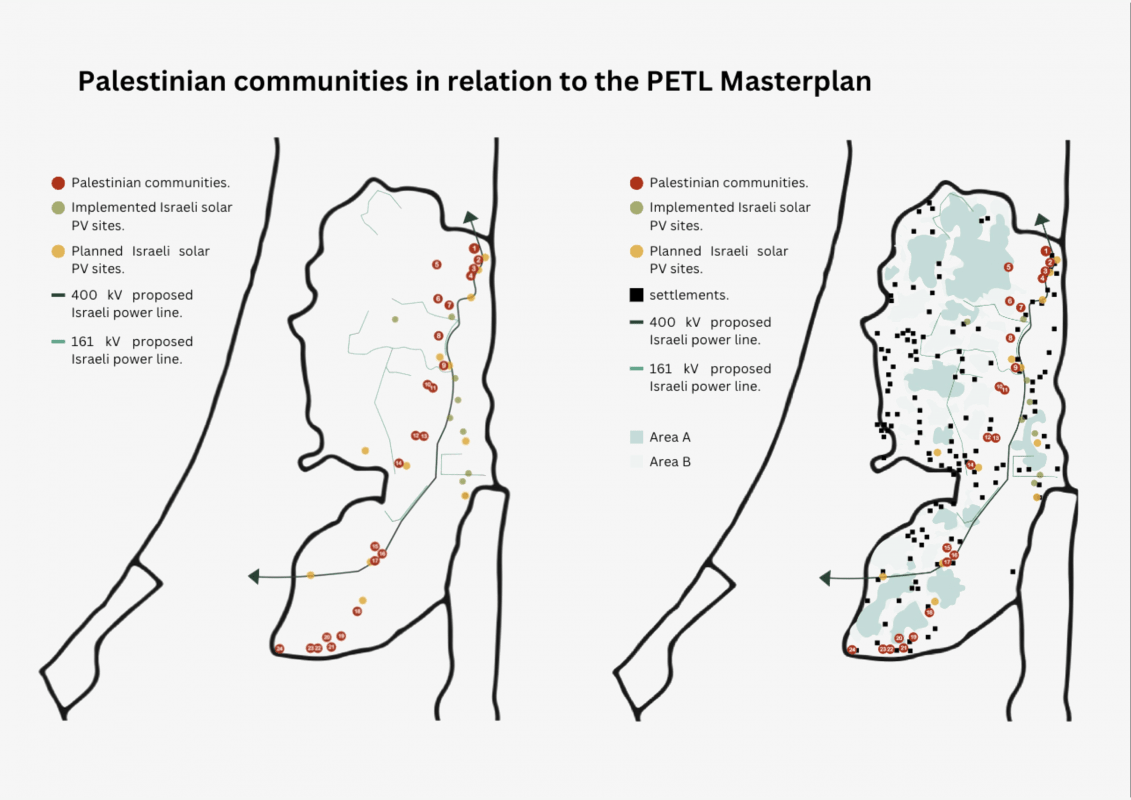
A map illustrating the proposed 400 KiloVolt power transmission line in relation to displaced Palestinian communities in the Occupied West Bank.
Source: Al-Haq 2025
Currently, Israel has four major solar farms in the West Bank, three of which are in the Jordan Valley, where solar panel equipment belonging to Palestinians has been seized by Israel. Since the forcible displacement of numerous Palestinian communities near the proposed new power line, several proposals for new Israeli solar farms have emerged for the area cleared of Palestinians along the power line. The Jordan Valley stands out as one of the most suitable locations for solar energy generation in the occupied West Bank, owing to its exceptionally high levels of solar radiation and favorable geographical conditions, such as extensive flat terrain ideal for developing solar installations. As illustrated in the map, this region has also become a focal point for forcible displacement of Palestinian communities, the establishment of illegal Israeli outposts, and significant development of power infrastructure under Israel's 2030 renewable energy plan.
Case Study: The Erasure of Wadi Al-Seeq:
Wadi Al-Seeq (Dhahr Al-Jabal) is one of 25 Palestinian communities forcibly displaced during the Israeli offensive on Gaza following October 7, 2023. Located 10 kilometers east of Ramallah, this Bedouin community was home to families from the Arab Al-Ka'abneh tribe, who have repeatedly faced displacement since their original expulsion from Tel Arad, northeast of Beersheba, in 1948. Over the decades, they have endured five forced displacements under Israeli occupation, with the latest incident occurring in October 2023 amid escalating settler violence.
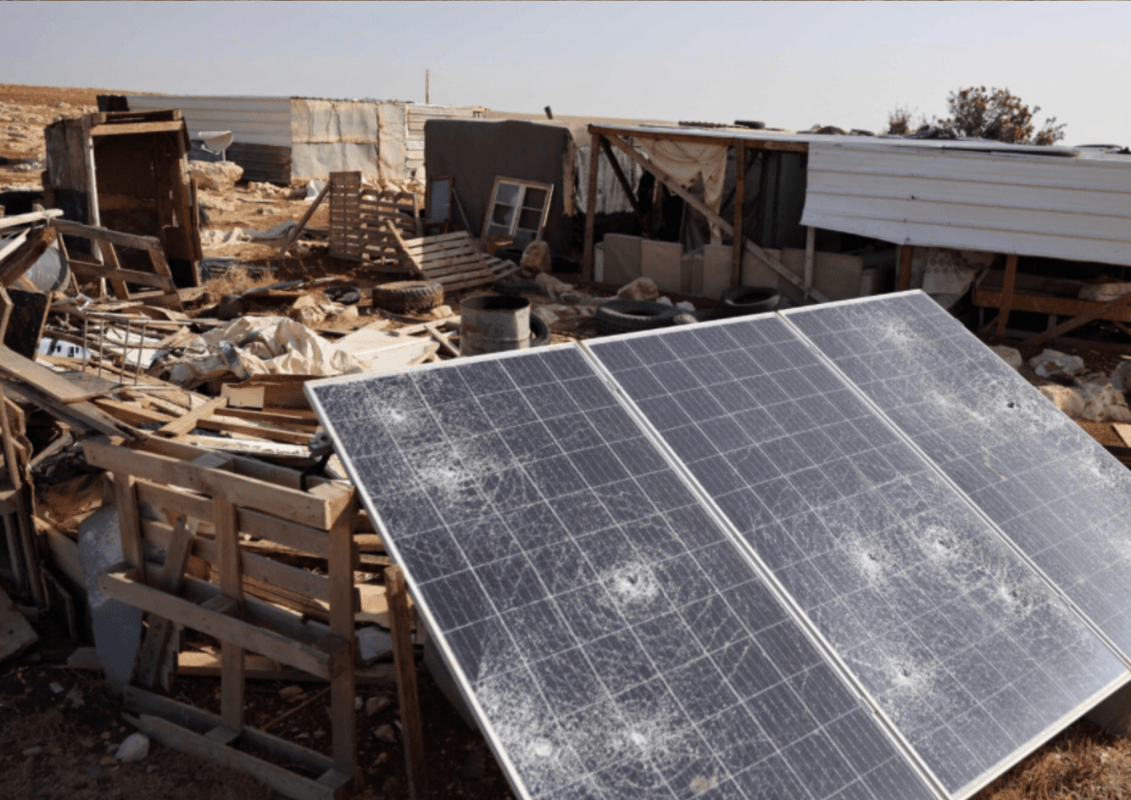
A picture of the destroyed solar panel used by resident of Wadi Al-Seeq during the illegal settlers attack on the community in October 2023.
Source: Alaa Badarneh 2023
By early 2023, settlers had already seized approximately 1,500 dunams of community land and 33 water wells, while regularly conducting violent attacks on residents. The main figure identified as orchestrating these assaults is settler Neria Ben Pazi, whom the EU Council has officially recognized for severe human rights abuses against Palestinians. Operating from an outpost just 300 meters away from Wadi Al-Seeq School, Ben Pazi led repeated attacks targeting both the community and its schoolchildren.
Following October 7, violence intensified significantly. Settlers, some dressed in military uniforms, frequently attacked homes and families, terrorizing children and adults alike. According to Israel's internal security agency (Shin Bet), Ben Pazi explicitly directed settlers to carry out multiple assaults against the Bedouin community after October 2023.
On October 12, around midday, approximately 80 personnel and 30 vehicles—including Israeli Occupation Forces (IOF), police, and settlers (in military and civilian clothing)—stormed Wadi Al-Seeq. Residents were given a one-hour ultimatum to leave under explicit threats of violence. Forced to flee on foot, they sought refuge in nearby villages. On the same day, three young men—two from the Colonization & Resistance Commission and one from the community—were arrested by Israeli forces and detained from 12:30 PM until 6:00 PM. Their detention ended only after coordinated intervention by Palestinian and Israeli representatives and ambulance teams, as documented by Al-Haq.
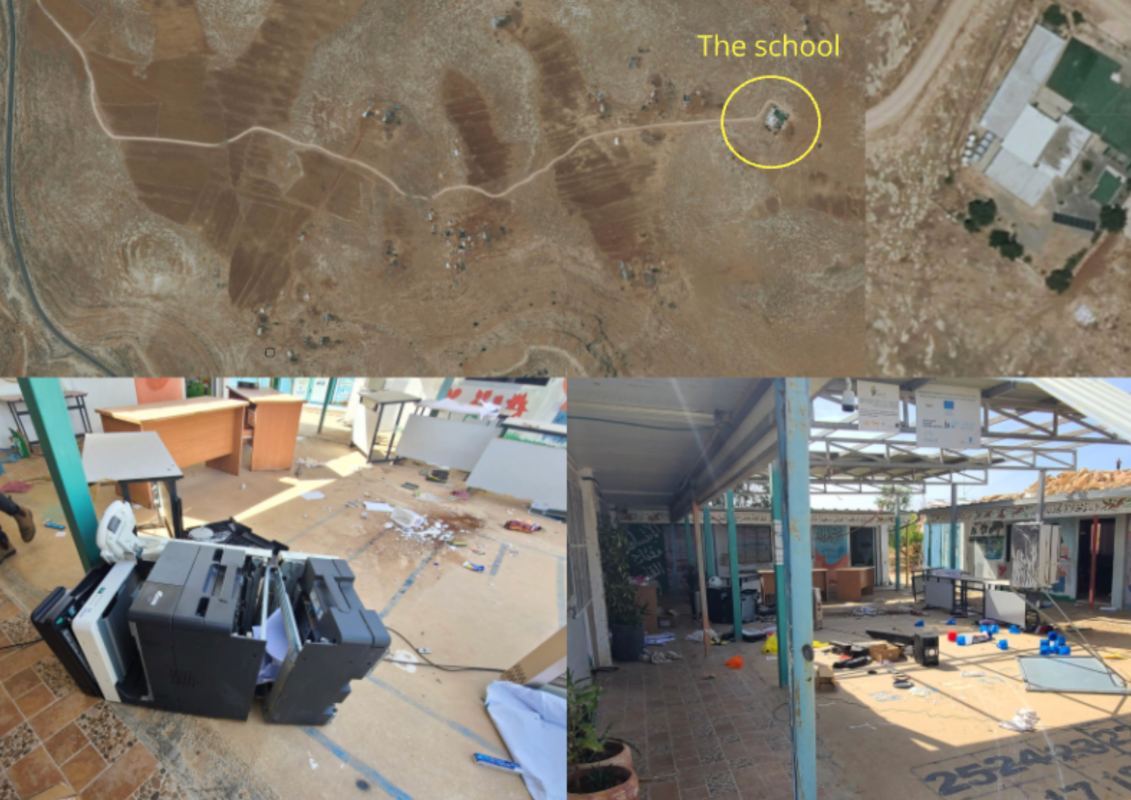
A geolocation of the attack on Wadi Al-Seeq elementary school in October 2023.
Source: Al-Haq 2025
Efforts by Palestinian authorities to allow residents immediate return to retrieve their belongings were initially denied by Israeli officials. After eight days of extensive coordination, residents finally returned under military escort, only to discover their community had been entirely devastated. Their homes were reduced to rubble; food supplies, water tanks, solar panels, and even their livestock had been stolen or destroyed. The main access road was blocked, and surveillance cameras were installed at the entrance, underscoring the totality of the devastation.
Legal Analysis:
Israel’s Zionist settler-colonial regime is premised on the elimination of the indigenous Palestinian people and their replacement with Jewish Israelis. Israel uses multiple methods to dispossess and displace Palestinians, including by imposing a coercive environment designed to systematically dominate and oppress Palestinians, establishing settlements and outposts, and ensuring complete impunity to violent settlers. The employment of settler violence, as a state-backed policy encouraged by high-level officials, including through the provision of arms, accompanied and sometimes actively supported by the IOF and unpunished by the Israeli judiciary, has also severely contributed to the dispossession and forcible displacement of Palestinians, depriving them of their means of subsistence and control over their land and natural resources.
The colonisation of Palestinian territory, including through Israel’s transfer of its own civilian population into the oPt –which amounts to a grave breach of the Fourth Geneva Convention and a war crime under the Rome Statute of the International Criminal Court (ICC) – is the core character of the Israeli occupation. Settler attacks are a direct result of Israel’s transfer of its own civilians into occupied territory. Additionally, the widespread and systematic attacks on the Palestinian population may amount to the crimes against humanity of deportation or forcible transfer, persecution, and apartheid per the Rome Statute of the ICC. Notably, the International Court of Justice concluded in its 2024 Advisory Opinion that Israel must “cease immediately all new settlement activities, and to evacuate all settlers from the [oPt]”.
Alarmingly, the approval of energy plans by the Israeli Energy Minister in the occupied West Bank signals the expansion of Israeli civil and administrative competences in the oPt, further proof of Israel’s annexation of the occupied West Bank – an internationally wrongful act of aggression, prohibited under Article 2(4) of the UN Charter, through the acquisition of territory by force. Importantly, this constitutes a stark violation of the inalienable right of the Palestinian people to self-determination.
Conclusion: Erasure as policy:
The forcible displacement of Palestinian communities in the occupied West Bank is part of a calculated strategy by Israeli authorities and settlers to seize land and resources. Through violence, intimidation, and coercive policies, Israel is systematically pushing Palestinian communities off their land to expand illegal settlements and integrate the West Bank into Israel's national energy plan.
This displacement we documented since October 2023 is not random; it is part of a broader settler-colonial objective that seeks to eliminate Palestinian presence from strategic areas, facilitated by settler violence and discriminatory policies. The use of infrastructure projects, such as powerlines and solar fields, further entrenches the appropriation of Palestinian resources and deepens their dependency.
These actions are violations of international law, including the Fourth Geneva Convention and the Rome Statute, which prohibit forcible displacement and the transfer of civilians into occupied territories. Immediate international intervention is required to halt these practices, protect Palestinian communities, and ensure their right to self-determination.


